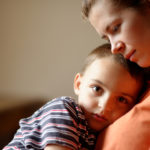Autism spectrum disorders emerge during early childhood and are characterized by social and communication difficulties and by stereotyped or repetitive behaviors and interests. The most recent estimates from the CDC’s Autism and Developmental Disabilities Monitoring (ADDM) Network indicate that about 1 in 44 children has been diagnosed with an autism spectrum disorder (ASD).
While genetic factors play a significant role in determining a child’s risk of autism, and can be identified in up to 25% of children with ASD, there has been increasing interest in examining whether environmental factors also play a role in the development of childhood autism. Various environmental exposures have been implicated, including vaccinations, mercury, air pollution, insecticides, and infection, as well as more recently, psychiatric medications including medications such as valproic acid (Depakote).
Prenatal exposure to valproate has been associated with an elevated risk (10%) for a broad range of congenital malformations, including spina bifida, as well as adverse neurodevelopmental sequelae, such a lower IQ and developmental delays in offspring. As a result, the American Academy of Neurology has recommended avoidance of valproate during pregnancy whenever possible.
In addition to these risks, a growing number of studies indicate that fetal valproate exposure may also increase the risk of autism.
Initial Clinical Reports: The possibility of an association between antenatal valproate exposure and risk for autism was first raised in 1997 and 2001, when clinicians reported on six patients with fetal valproate syndrome and autism (Williams et al, 2001). However, it was not until much later that larger studies assessed risk for autism in children prenatally exposed to valproate.
NEAD: One of the earliest studies to look systematically at this association was the Neurodevelopmental Effects of Antiepileptic Drugs (NEAD) study, an observational, multicenter study, which prospectively followed women with epilepsy who had used antiepileptic agents during pregnancy (Bromley et al, 2013). The researchers observed that the risk of neurodevelopmental disorders was about sixfold higher in 6-year-old children exposed to valproate monotherapy (6/50, 12.0%; adjusted OR 6.05) compared to non-exposed children (4/214; 1.87%). ASDs were the most commonly reported neurodevelopmental disorder.
Danish Cohort: In a much larger study,Christensen and colleagues reported on the results of a population-based study of 655,615 children born in Denmark from 1996 to 2006. Children were followed from birth for a maximum of 14 years. Among these children, 5437 were identified as having autism spectrum disorders (absolute risk of 1.53%), including 2067 with childhood autism (absolute risk 0.48%). Among the 508 children exposed to valproate, risk for ASD was about threefold higher (absolute risk of 4.42%; adjusted HR 2.9). The study did not find that higher doses of valproate were associated with a higher risk of autism.
Swedish Cohort: Using data from the Swedish medical register, Wiggs and colleagues assessed risk for ASD and ADHD in a group of 14,614 children born to mothers with epilepsy between 1996 and 2011 and followed up through 2013, including 699 mothers using valproic acid. After adjusting for potential confounding variables, they observed that the use of valproic acid was associated with a 2.3-fold increased risk for ASD (hazard ratio [HR] 2.30, 95% CI 1.53-3.47).
Dose of Valproic Acid: While the above studies did not observe an association between dose of valproic acid and risk for autism, some studies have observed higher risk in children exposed to higher doses of valproic acid. For example, in a study of 105 Australian children aged 6-8 years who were assessed by blinded raters (Woods et al, 2015), researchers observed that 11 AED-exposed children (10.5%) had elevated scores on the Childhood Autism Rating Scale (CARS). Valproate dose during pregnancy was a significant predictor of CARS scores.
Avoid Valproic Acid In Women of Childbearing Age
These studies provide evidence that fetal valproate exposure is associated with an increased risk for autism and autism spectrum disorders. While teratogenic risk is limited to the first trimester, fetal neurodevelopment occurs throughout the pregnancy. Thus, exposure to valproate at any point during the pregnancy carries significant risk. The use of valproate during pregnancy is not recommended; furthermore, the use of valproic acid should be avoided in women of childbearing age, and alternative medications should be considered, if at all possible.
Multiple studies have documented that prenatal exposure to valproate has been associated with an elevated risk (10%) of a broad range of congenital malformations including neural tube defects, as well as adverse neurodevelopmental sequelae. Given that 50% of pregnancies are unplanned in the United States, it is questionable if valproic acid can be used safely in women of chilbearing age.
We urge clinicians to adhere to the following recommendations set forth by the European Medical Agency regarding the use of valproic acid in women of childbearing age:
- If possible, an alternative to valproic acid should be used in women of reproductive age
- If valproic acid is the only option, women should use effective contraception and should be closely supervised
- Doctors who prescribe valproic acid to women of reproductive age must review the reproductive risks associated with this drug and must clearly explain the reason for choosing valproic acid over other options
- Women taking valproic acid should also take 4mg of folic acid daily to reduce the risk of birth defects in the setting of unplanned pregnancy.
Ruta Nonacs, MD PhD
References:
Bromley RL, Mawer GE, Briggs M, et al. The prevalence of neurodevelopmental disorders in children prenatally exposed to antiepileptic drugs.J Neurol Neurosurg Psychiatry. 2013 Jan 31.
Christensen J, Grønborg TK, Sørensen MJ, Schendel D, Parner ET, Pedersen LH, Vestergaard M. Prenatal valproate exposure and risk of autism spectrum disorders and childhood autism. JAMA. 2013: 24;309(16):1696-703
Meador KJ, Loring DW. Risks of in utero exposure to valproate. JAMA. 2013: 24;309(16):1730-1.
Wiggs KK, Rickert ME, Sujan AC, Quinn PD, Larsson H, Lichtenstein P, Oberg AS, D’Onofrio BM. Antiseizure medication use during pregnancy and risk of ASD and ADHD in children. Neurology. 2020 Dec 15;95(24):e3232-e3240.
Williams G, King J, Cunningham M, Stephan M, Kerr B, Hersh JH. Fetal valproate syndrome and autism: additional evidence of an association. Dev Med Child Neurol. 2001 Mar;43(3):202-6.
Wood AG, Nadebaum C, Anderson V, Reutens D, Barton S, O’Brien TJ, Vajda F. Prospective assessment of autism traits in children exposed to antiepileptic drugs during pregnancy. Epilepsia. 2015 Jul;56(7):1047-55.







Leave A Comment